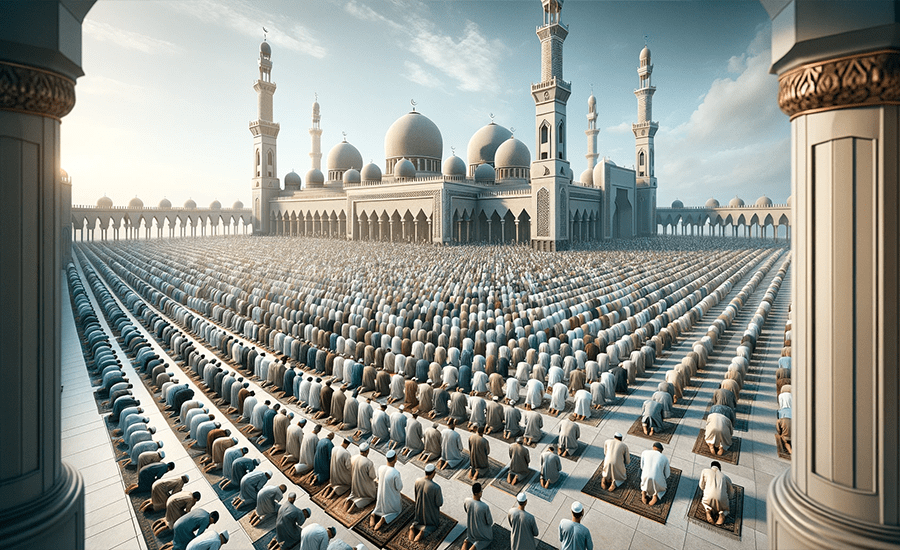
Eid, a time of joy and spiritual renewal for Muslims, is marked by the special prayers of Eid Salah. Understanding “how to pray Eid Salah” and “how to pray Eid Salah Hanafi” is not just about performing acts of worship; it’s about connecting with a centuries-old tradition that unites Muslims worldwide. In this comprehensive guide, we delve deep into the intricacies of Eid Salah, drawing from Islamic teachings, Quranic verses, and revered texts like ‘Bahar-e-Shariat‘ and ‘Durr-e-Mukhtar.‘ Our aim is to provide a detailed, step-by-step explanation, ensuring every Muslim can fulfill this significant prayer with understanding and devotion.
The Significance of Eid Salah in Islam
In the vast canvas of Islamic rituals, Eid Salah stands out as a symbol of unity, gratitude, and celebration. Occurring twice a year, Eid ul-Fitr and Eid ul-Adha bring together the global Muslim community in a shared act of worship. These festivals, deeply rooted in Islamic theology, are more than just cultural celebrations; they are moments of thanksgiving to Allah for the countless blessings bestowed upon His followers.
Method of Eid Salah (Hanafi)

To fully appreciate the method of Eid Salah, especially following the Hanafi school of thought, it’s essential to understand its unique components. The prayer comprises two Rakats, with additional Takbeers that differentiate it from the daily Salah.
- Intention (Niyyah): Begin by making an intention in your heart, saying, “I intend to perform two Rakats of نماز عید الفطر (Eid al-Fitr) or نماز عید الاضحیٰ (Eid al-Adha) prayer, with six additional تکبیر (Takbeers), for Allah, following this Imam.”
- Opening Takbeer and Thana: Raise your hands to your ears, proclaim “اللہ اکبر (Allahu Akbar)” and tie them below the navel. Start with the Thana, praising Allah.
- Additional Takbeers: After the initial Takbeer, raise your hands and say “اللہ اکبر (Allahu Akbar)” three more times, letting your hands hang after each declaration. This act symbolizes a deeper connection to the divine, acknowledging Allah’s greatness in every aspect of life.
- Recitation of Quran: The Imam then quietly recites تَعَوُّذ (Ta’awwuz) and تَسْمِیَہ (Tasmiyah), followed by reciting الحمد شریف (Alhamdu Sharif) and a سورۃ (Surah) aloud. This recitation is a moment to reflect on the Quran’s teachings and internalize its messages.
- Ruku and Sujood: Perform the Ruku and Sujood as in regular prayers, but imbued with the special intention of Eid.
- Second Rakat and Final Takbeers: In the second Rakat, after reciting Alhamdu and a Surah, perform three additional Takbeers without tying your hands, followed by a fourth Takbeer to enter Ruku. This sequence is a hallmark of Eid Salah, infusing the prayer with a distinctive character.
- Completion of Prayer: Conclude the prayer as per the usual Qa’idah, sitting and reciting the Tashahhud, Durud, and Dua.
References from Islamic Texts
Our understanding of Eid Salah is enriched by references from pivotal Islamic texts. For instance, ‘Bahar-e-Shariat‘ (Vol. 1, Page 781) and ‘Durr-e-Mukhtar‘ (Vol. 3, Page 61) provide detailed guidelines on the procedure, emphasizing the importance of each step in the Hanafi method.
Joining Eid Salah Late
A common concern among worshippers is how to join Eid Salah if one arrives late. According to Islamic jurisprudence, if you join in the first Rakat after the Imam has performed the additional Takbeers, you should say three Takbeers immediately. However, if the Imam is already in Ruku, join him without saying the Takbeers while standing. Instead, perform them in Ruku. If you join in the second Rakat, perform the missed Takbeers when you stand for your missed Rakat. These guidelines, detailed in ‘Bahar-e-Shariat‘ (Vol. 1, Page 782) and ‘Durr-e-Mukhtar‘ (Vol. 3, Page 64), ensure that even latecomers can fulfill their Eid Salah appropriately.
Conclusion
In conclusion, Eid Salah is not just a ritual; it’s a profound expression of faith and communal unity. By carefully following the steps outlined in Hanafi jurisprudence, enriched with insights from key Islamic texts, one can perform Eid Salah with proper understanding and reverence. As we embrace this practice, let us remember its deeper significance, transcending mere physical motions to become a heartfelt celebration of our faith. May Allah accept our prayers and grant us the wisdom to appreciate the true spirit of Eid. “اللہپاک ہماری مغفرت فرمائے اور ہمیں حقیقی عید نصیب ہو جائے (May Allah forgive us and grant us the true joy of Eid).”
FAQs
Q: What is the significance of performing Eid Salah, especially in the Hanafi school of thought?
A: Eid Salah is a central aspect of Islamic worship during the festivals of Eid ul-Fitr and Eid ul-Adha. In the Hanafi school of thought, it holds immense significance as it symbolizes unity, gratitude, and the commemoration of Allah’s blessings. It is a time when Muslims globally unite in a collective act of worship, demonstrating solidarity and spiritual obedience. The additional Takbeers in Eid Salah, unique to these occasions, highlight the special nature of these prayers, setting them apart from the daily Salah.
Q: How do I properly perform Eid Salah according to Hanafi jurisprudence?
A: To perform Eid Salah correctly following Hanafi jurisprudence, one should start with the intention (Niyyah) of performing two Rakats for either Eid ul-Fitr or Eid ul-Adha. The prayer includes six additional Takbeers – three in the first Rakat before the Quranic recitation and three in the second Rakat following the recitation. Understanding and following each step, from the initial Takbeer to the final sitting (Qa’idah), is crucial. The unique sequence of Takbeers and recitations embodies the spirit of Eid and is essential in fulfilling the prayer accurately.
Q: What are the guidelines for joining Eid Salah late, particularly in the Hanafi method?
A: In the Hanafi method, if you arrive late for Eid Salah, the way you catch up depends on the stage of the prayer you find the congregation in. If the Imam is still in the first Rakat, you should join and perform the remaining Takbeers. If the Imam is in Ruku or beyond, join quietly and compensate for the missed Takbeers in the subsequent Rakat. The focus is on maintaining the structure and sanctity of the Eid Salah, ensuring that even latecomers can participate meaningfully in the prayer.
Q: Is it necessary to recite any specific Surahs during Eid Salah in the Hanafi tradition?
A: While there is no mandatory requirement to recite specific Surahs during Eid Salah in the Hanafi tradition, it is recommended to recite Surah Al-A’la in the first Rakat and Surah Al-Ghashiya in the second, following the practice of the Prophet Muhammad (PBUH). This tradition enhances the spiritual experience, linking us to the Prophet’s (PBUH) way of celebrating these important Islamic festivals.
Q: How can I ensure that my Eid Salah is accepted and I truly understand how to pray Eid Salah Hanafi?
A: To ensure your Eid Salah is accepted, it’s important to perform it with sincere intention, proper understanding of the steps involved, and adherence to the timings prescribed for Eid prayers. Understanding how to pray Eid Salah according to Hanafi jurisprudence involves not just the physical acts but also a deep connection with the prayer’s significance. Engaging with its spiritual aspects, reflecting on the meanings of the recitations, and performing it in a state of cleanliness and concentration are all key to achieving a prayer that is both valid and spiritually fulfilling.
Source:
Dawat e Islami